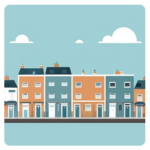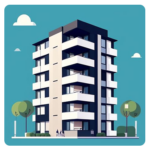

House Prices > Salford
| Year | Average Price | Transactions |
|---|---|---|
| 2025 (proj.) | £230,900 | 2,533 |
| 2024 | £221,300 | 1,302 |
| 2023 | £222,000 | 2,073 |
| 2022 | £233,000 | 2,685 |
| 2021 | £223,100 | 3,586 |
| 2020 | £204,100 | 1,954 |
| 2019 | £184,800 | 3,346 |
| 2018 | £173,200 | 2,786 |
Salford’s property prices have been marching steadily upwards, climbing with the relentless doggedness of a jog up Kersal Moor. The journey from pre-2018 to the present is best described as a winding ascent, with plenty of rest stops and the odd energetic sprint thrown in for good measure.
If you want the gritty details on why one Salford street commands more pounds per brick than another, take a closer look at Salford Property Prices Compared: What's Driving the Differences?
So, what should we remember? Salford’s property market remains robust, if occasionally unpredictable, giving both new buyers and seasoned investors plenty of food for thought—not to mention a convenient excuse to scrutinise their estate agent’s next sales pitch.

Avg. Property Price: 388,200
Avg. Size of Property
1,416 sq/ft
Avg. Cost Per Sq/ft
£294 sq/ft
Total transactions
249 (since 2021)

Avg. Property Price: 273,800
Avg. Size of Property
1,039 sq/ft
Avg. Cost Per Sq/ft
£271 sq/ft
Total transactions
1,032 (since 2021)

Avg. Property Price: 207,000
Avg. Size of Property
810 sq/ft
Avg. Cost Per Sq/ft
£266 sq/ft
Total transactions
3,239 (since 2021)

Avg. Property Price: 225,800
Avg. Size of Property
628 sq/ft
Avg. Cost Per Sq/ft
£366 sq/ft
Total transactions
1,486 (since 2021)
Let’s not beat about the bush - the Salford property market is anything but flat, and not just because of the skyline. Prices across different types paint a striking picture. Flats have soared in price per square foot more spectacularly than a Friday night out at MediaCity, while sprawling detached homes attract buyers with both bulging wallets and grand ambitions.
Starting with detached homes, these are the undisputed kings of Salford’s property jungle. While they come at a premium, their vast swathes of living space rival manor houses from a Brontë novel. But with nearly 250 sales since 2021, they’re not exactly unicorns - just not your everyday buy for most. The cost per square foot is carvable, but you do get lots of house for your money. Dream big, pay big.
Flats, meanwhile, are the real social climbers. Fashionable, compact, and traded more frequently than gossip at your local, these starter homes attract a steady crowd. A cost per square foot that could make a Londoner wince, but with almost 1,500 deals in just a couple of years, the appetite for city living remains insatiable. Young professionals, students, and anyone keen to live five minutes from a flat white will continue snapping them up.
Terraced properties remain the backbone of Salford life. These are the hardworking, never-let-you-down types. With well over 3,200 transactions, terraced homes trade hands so often it’s practically a local pastime. Affordability meets just enough space, meaning they’re snapped up by buyers who want substance over showiness and still a bit of elbow room.
Then, somewhere in the middle, the semi-detacheds quietly tick away. They balance price, space, and cost per square foot in a way that feels suspiciously sensible. Clearly, over a thousand deals since 2021 means a lot of people are choosing reliability over grandeur.
Oh, and if you’re still wondering why these differences exist, it’s not just the square footage or number of bedrooms. Local demand, redevelopment hotspots, and the gradual simmering of Salford’s market all combine. Want the nitty gritty? Dig deeper into what’s brilliantly skewing Salford house prices here.
| District | Avg Price (£) | Transactions |
|---|---|---|
| M3 | £238,600 | 3,478 |
| M5 | £197,100 | 5,190 |
| M6 | £190,600 | 4,453 |
| M7 | £233,200 | 2,444 |
| M28 | £270,600 | 9 |
| M50 | £185,900 | 2,228 |
Property prices across Salford are quietly shifting, each district carving out its own distinctive rhythm. It’s a patchwork of lifestyles, from the ripple of the Manchester Ship Canal in M50 to the leafy character of districts further afield. Even as prices tiptoe upwards, growth here feels more like a steady stroll along the Irwell than a frantic dash.
Some startling differences emerge between districts. Areas close to the vibrant city fringes, such as M3, stand out for their premium pricing. With their modern apartments and proximity to Spinningfields and Deansgate, it’s no surprise that there’s a steady pull for buyers with an eye for convenience and city buzz. Yet, just a short hop away, districts like M6 offer noticeably friendlier numbers. The pace in these areas is softer, the feel more residential, which creates options for those not seeking the heart-thumping pulse of central Salford.
In terms of action, some districts register hundreds, even thousands, of transactions in a year, creating a healthy level of choice for buyers. Compare that to the tiny handful of sales in places like M28, where properties change hands at almost glacial speed. Here, the housing stock is often older, with proud drives and established gardens – less churn, but prices reach for the sky. High value, low turnover.
Every corner of Salford has its own beat. Prices are inching up, but most districts offer something – whether it is city sparkle, suburban serenity, or a rarefied quiet only broken by the distant hum of trams and matchdays. For a detailed dig into what drives these differences, step onto Salford Property Prices Compared: What's Driving the Differences?.
Please remember these figures only reflect average sale prices and transaction counts.
Details such as property sizes and cost per square foot are not included here, which means the trends may not be fully reflected. For a sharper district analysis, head over to our blog. Thank you.
| City | Avg Price (£) | Transactions |
|---|---|---|
| Manchester | £218,700 | 67,269 |
| Sale | £360,300 | 5,601 |
| Altrincham | £387,700 | 4,708 |
| Heywood | £160,700 | 2,693 |
| Cheadle | £309,400 | 3,980 |
| Bury | £203,200 | 8,431 |
| Stockport | £265,800 | 20,414 |
| Ashton-Under-Lyne | £166,000 | 4,575 |
| Dukinfield | £178,900 | 1,615 |
| Oldham | £160,000 | 11,725 |
The property scene in Salford is buzzing, with the energy of a city that’s finally stepping out from its neighbours’ shadow. Buyers have started to notice that while Manchester grabs the headlines, Salford is quietly simmering like a pot ready to boil – affordable, lively, and just a stone’s throw from the city centre.
Compared to nearby areas, some observations stand out:
So what really makes Salford stand out? It’s the mixture. It’s fresh-thinking buyers, families ready to settle, bold investors, and a broad swathe of properties that mean something for every price bracket. You’re never far from the fun of Manchester, yet you still find houses where average prices haven’t hit the heady heights of those fashion-conscious suburbs. Salford’s property market is like a lively street party that everyone’s invited to – vibrant, friendly, and bursting with untapped potential.
So what’s the summary? Salford’s housing market is simmering like a stew left on the hob – slowly, steadily heating up. If you crave balance between location, price, and opportunity, Salford’s got the recipe just right.
Please remember, this comparison uses headline averages without adjusting for size or square footage.
Trends could appear less clear without adjusting for size or square foot price. For detailed comparisons, head to our blog.
Housing data is complex. We untangle it through soft recalibrations and a flexible model that brings every valuation closer to real life. Learn how we keep things sharp
Our site uses cookies. By using this site, you agree to the Privacy Policy and Terms of Use.